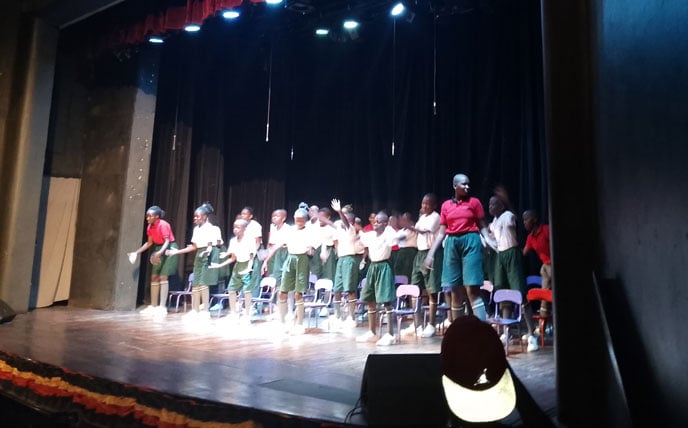
School children perform at the Youth Transformed 3-day Arts for Schools Festival at the National Theatre main auditorium in Kampala on April 8. PHOTO | COURTESY | PHILIP MATOGO
Uganda has 9,639,000 pupils enrolled in primary and secondary education. Of these, about 8,841,000 (92 percent) are enrolled in primary education, according to the Education Policy and Data Centre (EPDC).
Overall, there are about 21 million children (46 percent of the total population) in Uganda.
For many of these children, the classroom is where they spend most of their time. Per experts, it is imperative, then, that the time spent in classrooms builds the country’s children for what they will inevitably end up doing when outside the classroom. This could be any given profession, vocation, avocation, and, yes, even calling. The important thing here is how they access a chosen path tempered by the native impulse to create.
We are born artists
The legendary Italian artist Pablo Picasso once said: “Every child is an artist. The problem is how to remain an artist once he grows up.”
If one is to infer correctly, Picasso was saying that as children, we are born with the confidence to create. However, as children age, they rarely come of age. That is because this impulse to create is watered down as the child matures in the ways of the world, most of which squelch the creative spirit.
Youth Transformed (YT) hopes to reverse this trend with a prime eye on how a child’s inborn creativity is reborn with every experience and challenge. YT is a non-governmental organisation that creates safe, effective spaces for youthful creatives in Africa to explore, showcase and grow their talents effectively for future economic stability.
In so doing, every year, YT holds a three-day “Arts for Schools Festival” at the National Theatre main auditorium in Kampala. The last festival took place on April 8. This initiative is a Youth Transformed project under YT Arts For Schools Programme.
“It was established to create a safe space for creatives in schools. To ensure the process and the productivity of talent development is effectively achieved at an early age, the project paves the way for youthful creatives in pre-primary school, primary school, and secondary schools,” YT states in its profile, adding: “We believe that through this project, the creatives in schools will be in a position to explore and express their talents effectively because a talent that is exercised grows.”
The YT programme and other related programmes hope to nurture how children perceive the world around them after school hours, but mostly within the open four walls of the classroom.
Classrooms as creative tools
In a study conducted by the National Institutes of Health (NIH), one of the world’s foremost medical research centres and an agency in the US Department of Health and Human Services (HHS), a lot was revealed on how mental health impacts creativity. Titled Classroom Learning Environments and the Mental Health of First Grade Children, the study turned up some interesting findings.
Researchers discovered classrooms could positively influence four mental health components. Firstly, learning where a student’s ability to pay attention to and gain knowledge from learning materials and conversations comes into focus. Secondly, externalising problems, which is a student’s external response to big, uncomfortable feelings—like starting fights or taking their frustration out physically on objects around them. Thirdly, interpersonal behaviour, that is, a student’s ability to build and nurture positive relationships with the people around them. Lastly, internalising problems, i.e., a student’s ability to internally cope with difficult emotions like sadness and anxiety.
It was discovered that creativity, through art-based interventions, builds creative confidence. According to Ana Arriola-Kanada, adjunct lecturer and mentor at both the California Institute of the Arts and the University of California, Berkeley, creative confidence is a game changer.
“Creative confidence means creating a safe space for yourself and others to practice your deep craft and think within a physiological, emotional, physical, and intellectual safe area. It’s about having the self-assurance to take risks and express your unique creativity,” says Arriola-Kanada.
She adds: “Creative confidence involves overcoming the fear of judgment and failure, allowing for more open and imaginative thinking. Failing is learning. To fail means one can grow to glean insights for future ideations and possibilities.”
She recognises that creativity is something that is done, a practice. Not just a means of expression or an inborn gift. A classroom, if it allows children to explore their inner selves in a safe and honest space, promotes psychological safety by encouraging a child to express themselves without being judged or punished.
Art-based interventions bolster psychological safety in the classroom through collaborative communication and sharing. In such environments, the child is made to feel that their feelings and thoughts are valid. Thereupon, they are more willing to share them freely. Each one teaches one by the sharing of feelings and thoughts, communication results and helps each child visualise different concepts, buttress their storytelling abilities and teacherly skills.
A world safe for diversity
As each child is encouraged to reflect upon their lives and their environments, they are also encouraged to dialogue about specific topics, viewpoints and emotions. This airing of multifaceted inner realities conjures a diversity of societal being expressive of the heterogeneity of humanity.
When creativity is thereby fostered, it promotes shared meaning and collective (yet individuated) understanding surrounding different cultures, perspectives, and experiences. As creativity defines the child’s activities, they find that drama studios and theatre auditoriums are their natural habitats as they further bolster creativity and imagination.
This is why initiatives like Youth Transformed always lead to the National Theatre or places where self-expression and vulnerability are normalised as twin parts of the creative process. The nurturing of creative confidence in schools, particularly classrooms, cannot be achieved in isolation of the wider communities the children come from and return to. After all, growing up is going away and coming back home. So classroom expectations and practices must partly reflect the community in which they operate.
In Uganda, creativity is not placed at a premium where getting by is a handy option. However, the routinised thoughts and practices of our society can be used to create a culture of creativity out of a culture of repetition. In this vein, the creative is encouraged to create repetitively and consistently.






